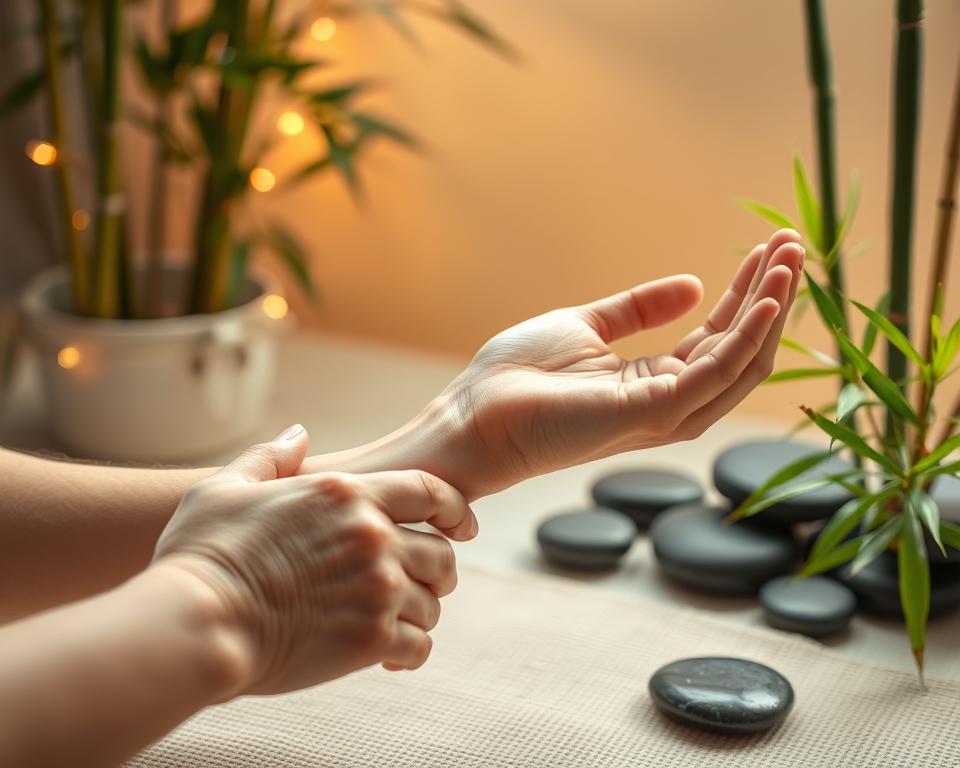
Acupressure for High Blood Pressure: Natural Relief
High blood pressure, or hypertension, is a big health issue for millions around the world. Many people turn to medicines to treat it. But, there’s a growing interest in natural ways to manage it. Acupressure, an old Chinese medicine, is becoming a popular choice for those looking for a natural fix.
Acupressure uses pressure on certain body points to help heal and balance. It aims to improve the flow of energy (qi). By pressing these points, acupressure can help control blood pressure, lower stress, and boost heart health. This article will show how acupressure can help with high blood pressure, explaining its basics and key points for relief.
If you want to add to your current treatment or try a natural way to manage high blood pressure, acupressure is a good option. It’s safe, easy to do, and can really help you take charge of your health. Learning about acupressure can open up new ways to find natural relief.
Read more interesting information at ::i-pasta
Understanding High Blood Pressure
High blood pressure, or hypertension, is a common health issue. It means your blood pressure stays high for a long time. Knowing the symptoms of high blood pressure, the risk factors for hypertension, and the conventional treatment options is key. This knowledge is important before looking into alternatives like acupressure.
Symptoms and Risk Factors
High blood pressure often doesn’t show symptoms. Some people might feel headaches, dizziness, or chest pain. But many people with high blood pressure don’t show any signs. So, it’s important to check your blood pressure regularly.
The risk factors for hypertension include family history, age, obesity, and not being active. Also, eating unhealthy, drinking too much alcohol, and having conditions like diabetes or kidney disease can increase your risk.
Conventional Treatment Options
The usual treatments for high blood pressure include lifestyle changes and medicine. Changing your diet, exercising regularly, and managing stress are often the first steps. If these aren’t enough, doctors might prescribe medicines like diuretics, ACE inhibitors, or calcium channel blockers. These help lower and control your blood pressure.
| Medication Class | Examples | Mechanism of Action |
|---|---|---|
| Diuretics | Hydrochlorothiazide, Furosemide | Reduce fluid and sodium levels in the body |
| ACE Inhibitors | Lisinopril, Enalapril | Inhibit the angiotensin-converting enzyme, reducing blood vessel constriction |
| Calcium Channel Blockers | Amlodipine, Nifedipine | Relax and dilate blood vessels by blocking calcium entry into the cells |
While these treatments work well for many, some people look for other ways to manage their blood pressure. Acupressure is one alternative they might consider.
What is Acupressure?
Acupressure is a gentle, non-invasive therapy based on Traditional Chinese Medicine (TCM). It uses light pressure on certain body points to help energy flow and heal naturally. This ancient method is now used to help with many health issues, like high blood pressure.
Principles of Traditional Chinese Medicine
Traditional Chinese Medicine is the base of acupressure. It sees the body as a balance of opposing forces, yin and yang. When this balance is off, energy flow, or qi, can get blocked.
TCM says many health problems, like high blood pressure, come from blocked qi. Acupressure aims to fix this by pressing on special points. This helps qi flow smoothly and supports healing.
“Acupressure is an ancient Eastern medicine technique that taps into the body’s natural ability to heal itself by stimulating specific points on the body.”
TCM stresses the need for mind, body, and spirit harmony. Acupressure is a holistic way to tackle health issues, including high blood pressure. It targets the body’s imbalances.
Acupressure for High Blood Pressure
Acupressure is a natural way to manage high blood pressure. It targets specific points to help control blood pressure and improve heart health. This section looks at how acupressure for high blood pressure can be part of a holistic plan.
Traditional Chinese Medicine (TCM) says our body’s energy, or chi, flows through meridians. When these paths get blocked, it can cause health problems like high blood pressure. Acupressure meridians for blood pressure regulation aim to balance these points to improve heart function.
The LI4 (Hegu) point, between the thumb and index finger, is key for pressure point massage for blood pressure control. Applying gentle pressure here can help lower blood pressure. The P6 (Neiguan) point on the inner forearm is also used for its blood pressure benefits.
| Acupressure Point | Location | Benefits for High Blood Pressure |
|---|---|---|
| LI4 (Hegu) | Between the thumb and index finger | Regulates blood flow and lowers blood pressure |
| P6 (Neiguan) | Inner forearm | Supports healthy blood pressure levels |
Adding acupressure for high blood pressure to a treatment plan can offer many benefits. These include less need for medication, better heart function, and overall well-being.
“Acupressure has been a game-changer in managing my high blood pressure. The simple yet effective pressure point massages have helped me significantly reduce my medication and feel more in control of my health.”
Acupressure Points for Hypertension
Acupressure experts have found that certain body points can help control high blood pressure. The LI4 (Hegu) and P6 (Neiguan) points are key for this purpose.
LI4 (Hegu) Point
The LI4 point is found on the back of the hand, between the thumb and index finger. It’s believed to calm the body, reducing stress and tension. This can help lower blood pressure. To apply pressure, use your thumb and index finger to gently squeeze and massage the area for a few minutes.
P6 (Neiguan) Point
The P6 point is on the inner forearm, about three finger-widths below the wrist crease. It’s thought to soothe the heart and blood vessels, possibly lowering blood pressure. To stimulate it, place your thumb on the inside of your forearm and gently press and circle the area for a minute or two.
| Acupressure Point | Location | Benefits for Hypertension |
|---|---|---|
| LI4 (Hegu) | Back of the hand, between the thumb and index finger | Helps reduce stress and tension, which can contribute to high blood pressure |
| P6 (Neiguan) | Inner forearm, about three finger-widths below the wrist crease | Has a soothing influence on the cardiovascular system, potentially helping to lower blood pressure |
By using these acupressure points, you can help manage your acupressure points for hypertension. Remember to apply gentle, sustained pressure for the best results.
Incorporating Acupressure into Your Routine
Adding acupressure to your daily routine can help manage high blood pressure naturally. Just a few minutes each day can make a big difference. It helps you take control of your blood pressure and might even cut down on medication.
To get the most out of acupressure for hypertension, follow these steps:
- Do acupressure at least once a day. It’s best in the morning or evening when you can focus.
- Set aside 10-15 minutes for each session. Focus on points that help with blood pressure.
- Use your fingertips or knuckles to apply firm pressure. Breathe deeply and relax while you do it.
- Make it a habit. Practice acupressure self-care at the same time every day.
By adding these acupressure practices for hypertension to your daily life, you’re taking a big step. It’s a natural way to manage your blood pressure and improve your health. Remember, small changes can make a big difference over time.
| Acupressure Technique | Benefits for Blood Pressure |
|---|---|
| Applying pressure to the LI4 (Hegu) point | Helps regulate blood pressure and relieve stress |
| Stimulating the P6 (Neiguan) point | Promotes relaxation and supports cardiovascular health |
Remember, incorporating acupressure into your routine is a natural way to handle high blood pressure. By making it a regular part of your self-care, you’re actively working on your health. It’s a holistic approach to managing hypertension.
Lifestyle Changes to Complement Acupressure
Acupressure is a great tool for managing high blood pressure. But, it works best when you also make lifestyle changes. A complete approach can lead to lasting results in controlling hypertension.
Dietary Modifications
Changing your diet can greatly affect your blood pressure. Eating more whole, unprocessed foods like fruits, veggies, whole grains, and lean proteins is good for your heart. Cutting down on sodium, saturated fats, and added sugars can also help lower your blood pressure.
Exercise and Stress Management
Regular exercise and managing stress are key for healthy blood pressure. Doing aerobic exercises like brisk walking, jogging, or swimming strengthens your heart and improves blood flow. Adding relaxation techniques like deep breathing, meditation, or yoga to your routine can help manage stress and improve your overall health.
“Combining acupressure with lifestyle changes like a healthy diet and regular exercise can have a powerful synergistic effect on blood pressure management.”
By combining acupressure with healthy eating, exercise, and stress management, you can take a big step towards better heart health. This approach can help prevent the serious problems that high blood pressure can cause.

Precautions and Contraindications
Acupressure is usually safe and non-invasive. But, it’s key to know some precautions and contraindications. This knowledge helps ensure acupressure is used safely for managing high blood pressure.
Precautions for Acupressure
Be cautious with acupressure in these situations:
- During pregnancy: Avoid certain points that might cause uterine contractions or harm the fetus.
- In the presence of bleeding disorders: Pressing on certain points can increase bleeding risk.
- In the case of open wounds or skin infections: Avoid acupressure to prevent irritation or infection.
- After recent surgery or injury: Use acupressure carefully to not disrupt healing.
Contraindications for Acupressure
Acupressure might not be good for people with these conditions:
- Severe or uncontrolled hypertension: Pressing on certain points might worsen high blood pressure.
- Certain cardiovascular conditions: Talk to a doctor before using acupressure if you have heart disease, stroke, or other heart issues.
- Acute infections or fever: Avoid acupressure to prevent worsening the body’s inflammatory response.
Always talk to a qualified acupressure practitioner or healthcare provider before starting acupressure. This is especially true if you have a medical condition or are on medication.
“Incorporating acupressure into your hypertension management plan can be a powerful tool, but it’s crucial to do so safely and under the guidance of a qualified professional.”
Success Stories and Testimonials
Acupressure is a natural way to manage high blood pressure. Many people have seen its benefits firsthand. Their stories show how acupressure can help with hypertension.
Sarah, a 45-year-old office worker, had high blood pressure for years. She was taking many medications but still had trouble controlling her blood pressure. After trying acupressure, she was able to cut down on her medication and keep her blood pressure healthy. She feels much better now.
Michael, a 52-year-old retiree, was diagnosed with hypertension a decade ago. He was skeptical about acupressure at first. But after a few sessions, he noticed his blood pressure improved a lot. He no longer needs to rely only on medication to manage his condition.
These stories show how acupressure can help with high blood pressure. It’s a natural and effective way to control blood pressure. People who use acupressure regularly have better blood pressure, need less medication, and feel healthier overall.
| Name | Age | Condition | Acupressure Outcome |
|---|---|---|---|
| Sarah | 45 | High Blood Pressure | Reduced medication dosage, maintained healthy blood pressure levels |
| Michael | 52 | Hypertension | Significant improvement in blood pressure readings, reduced reliance on prescription drugs |
These stories highlight the benefits of acupressure for high blood pressure and hypertension. We hope they inspire others to try this natural method for better heart health.
“The change in my overall well-being has been remarkable since I started using acupressure to manage my high blood pressure.”
– Sarah, 45-year-old office worker
Combining Acupressure with Conventional Treatments
For those with high blood pressure, mixing acupressure with medical treatments can be very helpful. It’s about combining these methods to control blood pressure better. This way, patients can manage their condition more effectively.
When using acupressure with conventional treatments for high blood pressure, it’s important to integrate acupressure with medication for hypertension. Also, using it alongside conventional hypertension therapies can lead to better results. This approach can help manage blood pressure and improve heart health.
Acupressure and Medication: A Complementary Approach
Acupressure can work well with hypertension medications, making them more effective. It targets specific points to improve blood flow, reduce stress, and help control blood pressure naturally. This can lead to better blood pressure management and less need for medication.
Acupressure and Lifestyle Modifications
Adding acupressure to conventional treatments like diet, exercise, and stress management creates a complete wellness plan. It helps with stress, relaxation, and supports the body’s natural blood pressure regulation. This makes for a well-rounded approach to health.
| Conventional Hypertension Therapies | How Acupressure Can Complement |
|---|---|
| Medication | Enhances effectiveness and reduces reliance |
| Dietary Changes | Supports relaxation and stress reduction |
| Exercise | Promotes overall well-being and recovery |
| Stress Management | Helps alleviate stress and improve relaxation |
By combining acupressure with conventional treatments for high blood pressure, people can get a more effective way to manage their condition. This mix of old and new therapies can lead to better blood pressure control, improved health, and less need for medication.

Acupressure for Preventing Hypertension
Acupressure is not just for managing high blood pressure; it can also help prevent it. By adding acupressure to your self-care routine, you can keep your blood pressure healthy. This can lower your risk of heart problems linked to high blood pressure.
Using acupressure as a preventative measure for hypertension boosts your heart health. It works by improving blood flow, easing stress, and supporting your body’s natural blood pressure balance. This is especially good for people at risk because of family history, lifestyle, or health issues.
Using acupressure to maintain healthy blood pressure also improves your overall health. It can help you relax, sleep better, and have more energy. This can lead to a healthier lifestyle, which lowers your risk of high blood pressure and heart problems.
| Acupressure Point | Benefits for Preventing Hypertension |
|---|---|
| LI4 (Hegu) | Helps regulate blood pressure, reduces stress, and improves circulation. |
| P6 (Neiguan) | Calms the mind, lowers blood pressure, and supports overall cardiovascular health. |
By making acupressure a regular part of your routine, you can keep your blood pressure in check. Pair it with a healthy diet, exercise, and stress management. Together, they make acupressure a strong ally against high blood pressure.
Finding a Qualified Acupressure Practitioner
Looking for a skilled acupressure practitioner can change your life when dealing with high blood pressure. Acupressure, a key part of Traditional Chinese Medicine, is a natural way to tackle high blood pressure. But, picking the right acupressure therapist is key for safe and effective treatment.
To find the right acupressure practitioner, here are some important tips:
- Check their credentials: Make sure they have the right training and licenses to practice in your area.
- Look at their experience: Find someone who has helped many people with high blood pressure. Ask about their approach and any special training.
- Good communication is important: A great acupressure professional should explain everything clearly. They should talk about how acupressure can help your high blood pressure.
- They should tailor the treatment to you: The best acupressure therapist will listen to your health history and lifestyle. They will create a treatment plan just for you.
- Check out referrals and reviews: Ask your doctor or look online for what others say. This can help you understand the practitioner’s reputation and success.
By following these tips, you can find a qualified acupressure practitioner. They will help you manage your high blood pressure with acupressure.
“Finding the right acupressure therapist was a game-changer for me in managing my high blood pressure. Their personalized approach and expertise made all the difference.”
Conclusion
Acupressure can be a great, natural way to handle high blood pressure. It’s based on traditional Chinese medicine. By learning about it and its key points, people can help control their blood pressure and keep their heart healthy.
Using acupressure with lifestyle changes and other treatments can help a lot. Always talk to a doctor before trying acupressure or any other new therapy.
Acupressure has many benefits for managing high blood pressure. It’s a natural way to help your heart stay healthy. By focusing on your health and trying acupressure, you can make a big difference.


